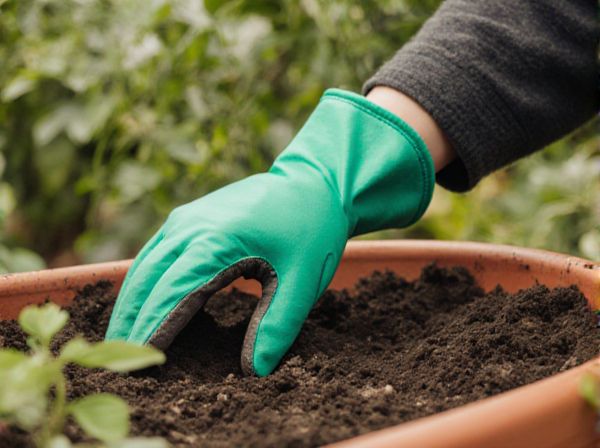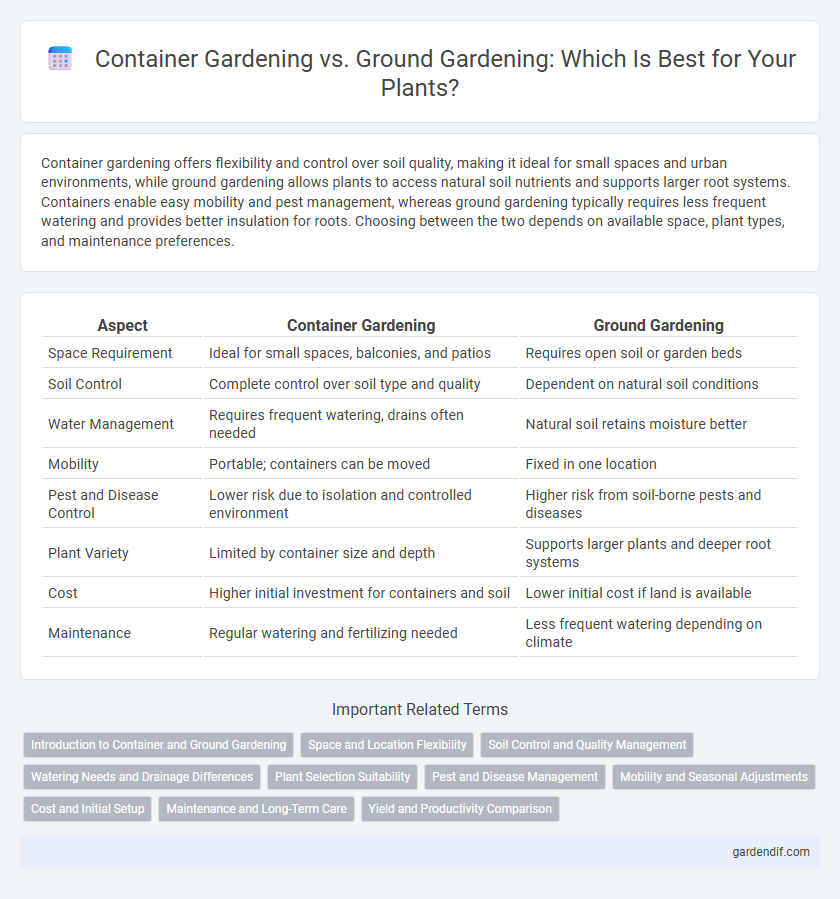
Container gardening vs Ground gardening Illustration
Container gardening offers flexibility and control over soil quality, making it ideal for small spaces and urban environments, while ground gardening allows plants to access natural soil nutrients and supports larger root systems. Containers enable easy mobility and pest management, whereas ground gardening typically requires less frequent watering and provides better insulation for roots. Choosing between the two depends on available space, plant types, and maintenance preferences.
Table of Comparison
| Aspect | Container Gardening | Ground Gardening |
|---|---|---|
| Space Requirement | Ideal for small spaces, balconies, and patios | Requires open soil or garden beds |
| Soil Control | Complete control over soil type and quality | Dependent on natural soil conditions |
| Water Management | Requires frequent watering, drains often needed | Natural soil retains moisture better |
| Mobility | Portable; containers can be moved | Fixed in one location |
| Pest and Disease Control | Lower risk due to isolation and controlled environment | Higher risk from soil-borne pests and diseases |
| Plant Variety | Limited by container size and depth | Supports larger plants and deeper root systems |
| Cost | Higher initial investment for containers and soil | Lower initial cost if land is available |
| Maintenance | Regular watering and fertilizing needed | Less frequent watering depending on climate |
Introduction to Container and Ground Gardening
Container gardening offers flexibility by allowing plants to be grown in pots or other containers, suitable for limited spaces such as balconies or patios. Ground gardening involves planting directly into the soil, providing plants with natural nutrients and room for root expansion, ideal for larger outdoor areas. Both methods cater to different space limitations and plant care needs, impacting growth and maintenance practices.
Space and Location Flexibility
Container gardening offers superior space and location flexibility compared to ground gardening, allowing plants to thrive in small balconies, patios, or urban settings where traditional gardens are not feasible. Containers can be easily relocated to optimize sunlight exposure, protect plants from extreme weather, or enhance aesthetic appeal. Ground gardening requires substantial space and fixed location, limiting adaptability and making it less suitable for restricted or variable urban environments.
Soil Control and Quality Management
Container gardening offers superior soil control by allowing precise selection and modification of soil composition, which reduces the risk of pests and diseases commonly found in ground gardening. Soil quality management is enhanced through controlled drainage and nutrient application, ensuring optimized growth conditions tailored to specific plant needs. Ground gardening, by contrast, often faces variability in soil texture, pH, and organic content, making consistent soil quality management more challenging.
Watering Needs and Drainage Differences
Container gardening requires more frequent watering due to limited soil volume and faster drying, while ground gardening benefits from natural moisture retention and deeper soil layers. Proper drainage in containers is critical to prevent waterlogging and root rot, often achieved with drainage holes and well-draining soil mixes. Ground gardening generally relies on the soil's inherent drainage capacity and the surrounding environment to manage water flow effectively.
Plant Selection Suitability
Container gardening suits small to medium-sized plants like herbs, succulents, and compact vegetables due to limited root space and controlled soil conditions. Ground gardening supports larger plants and deep-rooted varieties such as tomatoes, carrots, and shrubs, benefiting from natural soil depth and nutrient availability. Selecting plants based on growth habits and root systems optimizes health and yield in both gardening methods.
Pest and Disease Management
Container gardening offers superior pest and disease control compared to ground gardening due to better soil management and reduced exposure to soil-borne pathogens. Elevated containers allow for easier monitoring and targeted treatments, minimizing infestations from pests like aphids, spider mites, and fungal diseases such as powdery mildew. In contrast, ground gardening often faces challenges with nematodes, soil fungi, and recurring pest populations, necessitating integrated pest management strategies for effective control.
Mobility and Seasonal Adjustments
Container gardening offers superior mobility, allowing plants to be easily relocated to optimize sunlight exposure or protect them from adverse weather conditions. This flexibility enables gardeners to make timely seasonal adjustments by moving containers indoors or to sheltered areas, extending the growing season. In contrast, ground gardening lacks this portability, making it more challenging to adapt quickly to seasonal changes or environmental shifts.
Cost and Initial Setup
Container gardening requires a higher initial investment for pots, soil, and drainage materials compared to ground gardening, which often utilizes existing soil and space with minimal setup costs. While ground gardening involves preparing and amending the soil, container gardening offers controlled environments that reduce ongoing expenses related to pest control and soil replacement. Cost-efficiency depends on garden size, plant variety, and long-term maintenance preferences.
Maintenance and Long-Term Care
Container gardening requires more frequent watering and fertilizing due to limited soil volume and faster nutrient depletion, while ground gardening benefits from natural soil ecosystems that retain moisture and nutrients longer. Containers demand regular monitoring for drainage issues and root health to prevent plant stress, whereas ground gardens rely on soil amendments and mulching to maintain fertility over time. Long-term care in container gardening includes repotting and soil replacement every few seasons, contrasting with the perennial soil improvement practices inherent in ground gardening.
Yield and Productivity Comparison
Container gardening offers controlled soil conditions and precise nutrient management, often resulting in higher yields per square foot compared to ground gardening. Ground gardening allows for deeper root systems and natural soil ecosystems, which can enhance long-term productivity but may face challenges like soil pests and variable drainage. Studies indicate container gardens can produce up to 30% more yield in limited spaces due to optimized resource use and reduced competition.
Container gardening vs Ground gardening Infographic

 gardendif.com
gardendif.com